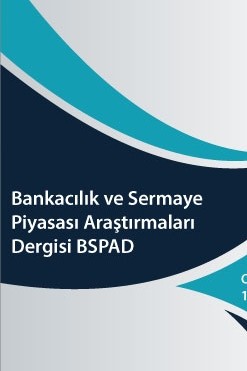Çoklu Yapısal Kırılmalar Altında Petrol Fiyatlarının Türk Hisse Senedi Piyasaları Üzerindeki Etkisinin İncelenmesi
Bu çalışmada yapısal kırılmalar altında petrol fiyatlarının Türk hisse senedi piyasaları üzerindeki etkisi incelenmiştir. Hisse senedi endeksleri olarak BIST100, BIST Mali, BIST Sınai ve BIST Hizmet endeksleri, petrol fiyatlarını temsilen ise Brent petrol fiyatları kullanılmıştır. Serilerde yapısal bir değişim olup olmadığı Peron ve Yabu (2009) testi ile modellerde bir rejim değişimi olup olmadığı ise Bai ve Perron (1998, 2003) testi ile incelenmiştir. Serilerin durağanlığının tespitinde Carrion-i Silvestre vd. (2009) yapısal kırılmalı birim kök testinden, değişkenler arasındaki uzun dönemli ilişkisinin tespitinde ise rejim değişimine izin veren Gregory ve Hansen (1996) ile Hatemi-J (2008) koentegrasyon testlerinden yararlanılmıştır. Nedensellik analizinde ise rejim değişim dönemleri dikkate alınarak Toda-Yamamoto (1995) testi kullanılmıştır. Çalışma bulguları tüm dönem dikkate alındığında petrol fiyatları ile Türk hisse senedi piyasaları arasında uzun dönemli ve pozitif bir ilişki olduğuna işaret etmektedir. Rejim değişimleri dikkate alındığında ise petrol fiyatlarında sert fiyat hareketlerinin yaşandığı dönemlerde petrol fiyatlarının Türk hisse senedi piyasalarını negatif yönde etkilediği ve değişkenler arasındaki nedensellik ilişkisinin ise giderek zayıfladığı belirlenmiştir.
Anahtar Kelimeler:
Petrol fiyatı, Hisse senedi piyasası, Yapısal kırılmalar
___
- Aloui, C., Nguyen, D.K. & Njeh, H. (2012). Assessing the Impact of Oil Price Fluctuations on Stock Returns in Emerging Markets. Economic Modeling, 29, 2686-2695.
- Bai, J. & Perron, P. (1998). Estimating and Testing Linear Models with Multiple Structural Changes. Econometrica, 66, 47–78.
- Bai, J. & Perron, P. (2003). Computation and Analysis of Multiple Structural Change Models. Journal of Applied Econometrics, 18, 1–22.
- Basher, S. & Sadorsky, P. (2006). Oil Price Risk and Emerging Stock Markets. Global Finance Journal, 17, 224-251.
- Basher, S.A., Haug, A.A. & Sadorsky, P. (2012). Oil Prices, Exchange Rates and Emerging Markets Stock. Energy Economics, 34, 227-240.
- Beckmann, J. & Czudaj, R. (2013). Oil Prices and Effective Dollar Exchange Rates. International Review of Economics and Finance, 27, 621–636.
- Carioni-i Silvestre, J.L, Kim, D. & Perron, P. (2009). GLS-Based Unit Root Tests with Multiple Structural Breaks under the both the null and the Alternative Hypothesis. Econometric Theory, 25, 1754-1792.
- Cong, R.G, Wei , Y.M., Jiao, J.L. & Fan, Y. (2008). Relationships between Oil Price Shocks and Stock Market: An Empirical Analysis from China. Energy Policy, 36, 3544– 3553.
- Cunado, J. & Perez de Gracia, F. (2003). Do Oil Price Shocks Matter ? Evidence for Some European Countries. Energy Economics, 25,137-154.
- Dagher, L. & El Hariri, S. (2013). The Impact of Global Oil Price Shocks on the Lebanese Stock Market. Energy, 63 , 366-374.
- Fan, Y. & Xu, J-H. (2011). What has Driven Oil Prices since 2000 ?. A Structural Change Perspective. Energy Economics, 33,1082-1094.
- Fang, C.R. & You, S.Y. (2014). The Impact of Oil Price Shocks on the Large Emerging Countries' Stock Prices: Evidence from China, India and Russia. International Review of Economics and Finance, 29, 330–338.
- Ghosh, S. & Kanjilal, K. (2014). Co-Movement of International Crude Oil Price and Indian Stock Market : Evidence from Non-Linear Cointegration Tests. Energy Economics, 53,11-117.
- Gregory A.W. & Hansen, B.E. (1996). Residual-based Tests for Cointegration in Models with Regime Shifts. Journal of Econometrics , 70, 99-126.
- Hamilton, J.D. (1983). Oil and the Macroeconomy since World War II. Journal of Political Economy, 9, 228-248.
- Hamilton, J.D. (2003). What is an Oil Shock ? ”. Journal of Econometrics, 113, 363-398.
- Hammoudeh, S., Bhar, R. & Thompson, M.A. (2010). Re-Examining the Dynamic Causal Oil–Macroeconomy Relationship. International Review of Financial Analysis, 19, 298–305.
- Hatemi-J A. (2008). Tests for Cointegration with two Unknown Regime Shifts with an Application to Financial Market Integration. Empirical Economics, 35, 497–505.
- Kapusuzoğlu, A. (2011). Relationship between Oil Price and Stock Market: An Empirical Analysis from Istanbul Stock Exchange (ISE). International Journal of Economics and Finance, 3, 99-106. Li, S.F., Zhu, H.M. & Yu, K. (2012). Oil Prices and Stock Market in China: A Sector Analysis Using Panel Cointegration with Multiple Breaks. Energy Economics, 34,1951-1958.
- Masih, R., Peters, S. & De Mello, L. (2011). Oil Price Volatility and Stock Price Fluctuations in an Emerging Market : Evidence From South Korea. Energy Economics, 33, 975–986.
- Narayan, K.P. & Narayan, S. (2010). Modeling the Impact of Oil Prices on Vietnam’s Stock Prices. Applied Energy, 87, 356-361.
- Pan, Z. (2014). Modelling Tail Dependence between Energy Market and Stock Markets in the BRIC Countries. Applied Economics Letter, 21, 789-794.
- Park, J. & Ratti, R.A. (2008). Oil Price Shocks and Stock Markets in the U.S. and 13 European Countries. Energy Economics, 30 , 2587–2608.
- Perron, P. & Yabu, T. (2009). Testing for Shifts in Trend with an Integrated or Stationary Noise Component. Journal of Business and Economic Statistics, 27, 369-396.
- Reboredo, J.C., Rivera-Castroa, M.A. & Zebende, G.F. (2014). Oil and US dollar exchange rate dependence: A detrended cross-correlation approach. Energy Economics, 42,132–139.
- Sadorsky, P. (2006). Modeling and forecasting petroleum futures volatility. Energy Economics, 28, 467- 488.
- Sadorsky, P. (1999). Oil price shocks and stock market activity. Energy Economics, 21, 449-469.
- Sukcharoen, K., Zohrabyan, T., Leatham & D., Wu, X. (2014). Interdependence of Oil Prices and Stock Market Indices: A Copula Approach. Energy Economics, 44, 331–339.
- Toda, H.Y. & Yamamoto, T. (1995). Statistical Inference in Vector Autoregressions with Possibly Integrated Processes. Journal of Econometrics, 66, 225-250.
- Ünlü, U. & Topçu, M. (2012). Petrol Fiyatları Hisse Senedi Piyasalarını Doğrudan Etkiler mi ? İMKB Örneği. İktisat, İşletme ve Finans, 27, 75-88.
- Zhu, H.M., Li, R. & Li, S. (2014). Modelling Dynamic Dependence Between Crude Oil Prices and Asia-Pacific Stock Market Returns. International Review of Economics and Finance, 29, 208–223.
- ISSN: 2651-3560
- Başlangıç: 2017
- Yayıncı: Aysel GÜNDOĞDU
